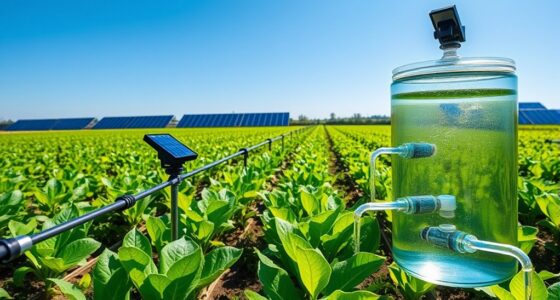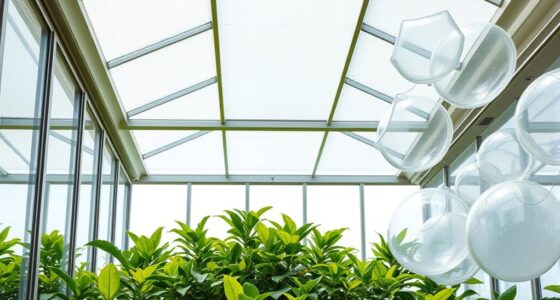ETFE films are lightweight, highly durable materials with excellent UV resistance and transparency, making them ideal for modern architectural projects. They resist fading and weathering, reducing maintenance costs over time. While they excel in supporting innovative designs and sustainability, they can be more expensive to install initially. Proper installation and monitoring are key to maximizing their lifespan. If you explore further, you’ll discover how these versatile films can transform your building’s aesthetics and longevity.
Key Takeaways
- ETFE films offer exceptional UV resistance, high transparency, and durability, making them ideal for long-lasting architectural applications.
- Their main advantages include reduced maintenance costs and the ability to support sustainable building designs.
- Installation involves tensioned mounting on supporting structures, ensuring uniform surface and resistance to environmental factors.
- Common use cases include large-scale stadiums, atriums, and exterior facades requiring light transmission and weather resilience.
- Despite benefits, ETFE films can be more costly initially and require precise installation to prevent damage and ensure longevity.

Have you ever wondered why ETFE films are becoming a popular choice for modern architectural projects? The answer lies in their impressive combination of durability, transparency, and versatility. One key feature that makes ETFE films stand out is their exceptional UV resistance. Unlike traditional plastics that degrade and discolor over time when exposed to sunlight, ETFE films are designed to withstand harmful ultraviolet rays without losing their clarity or strength. This UV resistance guarantees that your building maintains its aesthetic appeal and structural integrity for decades, reducing maintenance costs and the need for frequent replacements.
When it comes to installing ETFE films, employing the right techniques is vital to maximize their benefits and guarantee long-lasting performance. Because ETFE is a lightweight, flexible material, installation methods differ from those used with glass or rigid plastics. Typically, the films are mounted on a supporting structure—often a framework of cables, aluminum, or steel—using specialized clips or tensioning systems. Proper tensioning is essential; it prevents sagging, reduces stress points, and helps the film respond to environmental factors like wind and temperature fluctuations. Skilled installation technicians pay close attention to sealing and anchoring, ensuring the films are securely fastened while allowing for thermal expansion and contraction. Using industry-approved techniques, such as pre-stretching the film before installation and applying a consistent tension, helps prevent wrinkles or tears and guarantees that the surface remains smooth and uniform over time.
Furthermore, the installation process involves careful planning of the panel sizes and joint configurations to minimize seams, which could otherwise affect the film’s UV resistance and overall durability. Modern installation techniques leverage computer-aided design (CAD) and advanced tensioning equipment to achieve precise alignments, making the process more efficient and reliable. You’ll also want to consider environmental factors during installation—such as temperature, wind speed, and weather conditions—to avoid compromising the integrity of the film. Proper handling and installation not only preserve the UV resistance of the ETFE but also enhance its lifespan, ensuring your investment pays off in the long run. Additionally, integrating AI-powered monitoring systems can help track the condition of the film over time, allowing for proactive maintenance and ensuring sustained performance.
Frequently Asked Questions
How Does ETFE Compare to Traditional Glass in Cost?
When comparing ETFE to traditional glass, you’ll find ETFE generally costs less upfront, making it a smart choice for budget considerations. Its lower material and installation costs help you stay within your project budget. Plus, ETFE’s lightweight nature reduces structural support expenses. While glass might offer better longevity in some cases, ETFE’s affordability and ease of installation make it a cost-effective solution for many applications.
What Are the Environmental Impacts of Manufacturing ETFE Films?
Manufacturing ETFE films is like planting a seed for the future, but it does have environmental impacts. You’ll find that sustainable manufacturing practices and eco-friendly materials help minimize energy consumption and reduce emissions. While production involves some chemical processes, advancements aim to lower pollution. By choosing eco-conscious methods, you support a greener footprint, making ETFE films a more sustainable choice for eco-minded builders and architects.
Can ETFE Films Be Recycled After Use?
Yes, you can recycle ETFE films. The recycling processes involve melting and reprocessing the material, making it possible to reuse ETFE for new applications. This contributes to material sustainability by reducing waste and conserving resources. When you handle ETFE recycling properly, you help minimize environmental impact, promoting a circular economy. Keep in mind that specialized facilities are needed to guarantee effective recycling of ETFE films.
How Does ETFE Perform in Extreme Weather Conditions?
ETFE films stand strong like a fortress against extreme weather, showcasing remarkable weather resilience. Their durability factors mean they resist UV rays, high winds, hail, and temperature fluctuations without cracking or fading. You’ll find them performing reliably in harsh environments, maintaining clarity and integrity over time. So, when weather takes a turn, ETFE remains a steadfast partner, protecting your structures with resilience that’s built to last.
Are There Any Known Health Risks Associated With ETFE Exposure?
You don’t need to worry much about health concerns from ETFE exposure, as it’s considered safe. The chemical exposure from ETFE films is minimal, and they don’t emit harmful fumes under normal conditions. However, if you handle or dispose of ETFE improperly, there might be some concerns. Overall, ETFE is deemed safe for use in construction and other applications, with no significant health risks for users or the environment.
Conclusion
ETFE films stand as a shining beacon of innovation, offering durability, transparency, and flexibility that transform architectural dreams into reality. While they come with some downsides, their versatility makes them a game-changer in modern design. Imagine a world where your buildings breathe with light and resilience, like a delicate yet unbreakable wing soaring through the sky. With ETFE, you’re not just building structures—you’re crafting luminous, resilient masterpieces that inspire and endure.










